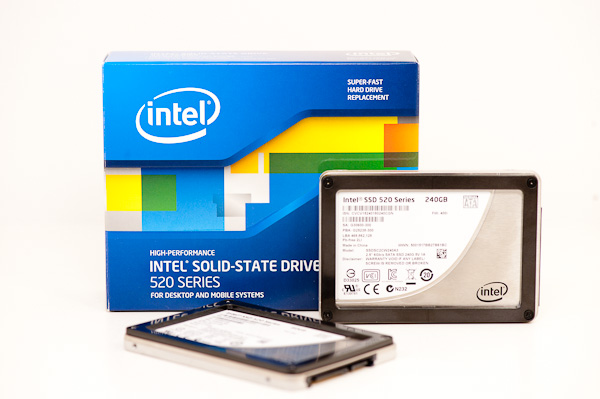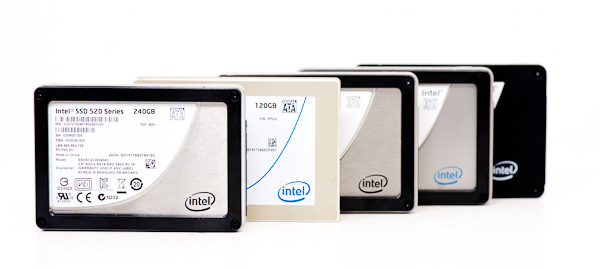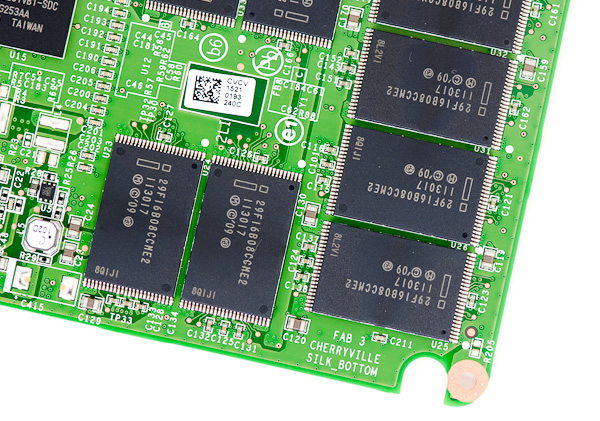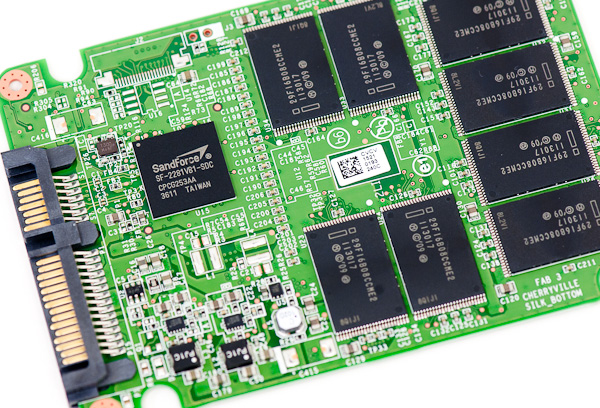Intel SSD 520 Review: Cherryville Brings Reliability to SandForce
by Anand Lal Shimpi on February 6, 2012 11:00 AM ESTIntel was rumored to be working on a SandForce based drive for several months now, but even the rumors couldn't encapsulate just how long Intel and SF has worked on this drive. According to Intel, the relationship began 1.5 years ago. Still lacking a 6Gbps controller of their own and wanting to remain competitive with the rest of the market, Intel approached SandForce about building a drive based on the (at the time) unreleased SF-2281 controller. Roughly six months later, initial testing and validation began on the drive. That's right, around the time that OCZ was previewing the first Vertex 3 Pro, Intel was just beginning its extensive validation process.
Codenamed Cherryville, Intel's SSD 520 would go through a full year of validation before Intel would sign off on the drive for release. In fact, it was some unresolved issues that cropped up during Intel's validation that pushed Cherryville back from the late 2011 release to today.
Intel's strenuous validation will eventually make SandForce's drives better for everyone, but for now the Cherryville firmware remains exclusive. Intel wouldn't go on record with details of its arrangement with SandForce, but from what I've managed to piece together the Intel Cherryville firmware is exclusive for a limited period of time. That exclusivity agreement likely expires sometime after the SF-2281 is replaced by a 3rd generation controller. There are some loopholes that allow SandForce to port bug fixes to general partner firmware but the specific terms aren't public information. The important takeaway is anything fixed in Intel's firmware isn't necessarily going to be fixed in other SF-2281 based drives in the near term. This is an important distinction because although Cherryville performs very similarly to other SF-2281 drives, it should be more reliable.
As Intel has been working on this firmware for quite a while, it's likely that the 520 uses an older branch of the SF-2281 firmware that has been updated over the past twelve months.
The BSOD is Back, but Not on Intel
Back in October SandForce announced that it had discovered a firmware issue that resulted in unexpected BSODs on SF-2281 drives on certain platforms. Why it took SandForce several months to discover the bug that its customers had been reporting for a while is a separate issue entirely. SandForce quickly pushed out the firmware to OCZ and other partners. Our own internal testing revealed that the updated firmware seemed to have cured the infamous BSOD.
Just as background, our SSD testing is rarely over once the review goes live. Any drive we recommend gets tossed into a primary use machine somewhere within the company. We keep track of drive behavior, including any bugs or performance issues over time. This long term testing process takes place over months. The results of these long term tests are folded into future reviews and recommendations.
The BSOD is caused by a bug in SandForce's power state logic that ultimately results in the drive disconnecting from the system while it's running. It turns out that Windows isn't a fan of you hot un-plugging the drive it's running on, which results in the BSOD. We had two systems that exhibited the BSOD, both of which were fixed by the update last October.

As luck would have it, our own Brian Klug happened to come across an unexpected crash with his 240GB non-Intel SF-2281 based SSD two weeks ago when he migrated it to another machine. The crash was an F4 BSOD, similar in nature to the infamous BSOD issue from last year. While two of the systems we reproduced the BSOD bug on were cured by last year's firmware update, Brian's system (an X58/Core i7 build) was BSODing regularly playing Battlefield 3. Games end up being a great way to trigger the SF-2281 BSOD issue as they frequently switch between periods of idle and load, which does a good job of stressing the power state logic in SandForce's firmware. I immediately sent Brian an Intel SSD 520 to see if the BSOD remained on Intel's drive. Switching to Cherryville caused Brian's BSODs to go away. Indeed most end user reports of SF-2281 BSODs went away with the fixed firmware, but we've still heard of isolated issues that remain unresolved. Whatever Intel has done with the 520's firmware seems to have fixed problems that still remain in the general SF-2281 firmware.
This is actually a dangerous precedent as it means one of two things. The first possibility is that SandForce has been made aware of flaws in its current firmware and chooses against (or is legally prevented from) disclosing it to its partners. The second possibility, and arguably even worse for SandForce, is that Intel was able to identify and fix a bug in the SF-2281 firmware without SandForce knowing it existed or was addressed. I suspect it's the former but as no one is willing to go on the record about the Intel/SandForce agreement I can't be certain.
Intel did go on record saying that the 520 is expected to have far fewer F4/F7 BSODs than any other SF-2281 drive. I asked Intel if I should read into the phrase "far fewer", but the answer was no - the 520 is expected to have similar reliability to the Intel SSD 510 and 320.
At the end of the day that's what Intel really brings to the table with the 520. As you'll soon see, performance isn't very different compared to other SF-2281 based drives. Intel's biggest advantage comes from the unique firmware that ships with the drive. Intel is also quick to point out that while other SF-2281 manufacturers can purchase the same Intel 25nm MLC NAND used on the 520, only Intel's drives get the absolute highest quality bins and only Intel knows how best to manage/interact with the NAND on a firmware level. While it's nearly impossible to prove most of this, the fact that we're still able to reproduce a BSOD on the latest publicly available SF-2281 firmware but not on the SF-2281 based Intel SSD 520 does say a lot about what you're paying for with this drive.
And you are paying a premium for the 520 compared to other SF-2281 based SSDs on the market today:
| Intel SSD 520 Price Comparison | |||||||
| 60GB | 120GB | 180GB | 240GB | 480GB | |||
| Intel SSD 520 (SF-2281) | $149 | $229 | $369 | $509 | $999 | ||
| Kingston HyperX (SF-2281) | N/A | $205 | N/A | $420 | N/A | ||
| OCZ Vertex 3 (SF-2281) | $95 | $190 | $240 | $375 | $850 | ||
| Samsung SSD 830 | $110 | $220 | N/A | $360 | $800 | ||
Last year Intel hinted at a move from the consumer market to enterprise server and client markets. The 520's higher price likely won't matter there, but for consumers the higher price is noticeable - particularly with good options from companies like Samsung now available on the market.














138 Comments
View All Comments
km23 - Monday, February 6, 2012 - link
What drive would you suggest for a Mac Pro? I have an early 2008 with 3G connection. I keep reading about the Mercury drives from Macsales. Any suggestions? Thanks.Beenthere - Monday, February 6, 2012 - link
WAIT for SSD makers to sort the Bugs out of their SSDs. Contrary to what Intel says, I think that's the only way we will have any idea of the reliability of the 520 series SSDs. Maybe in 12 months enough guinea pigs will have found most of the Bugs.troystarr - Tuesday, February 7, 2012 - link
I understand why IOPS would go down for smaller capacity drives with fewer NAND die to interleave, but I'm curious why it would go down when the capacity goes up.haa - Tuesday, February 7, 2012 - link
When using SSDs in laptops whole disk encryption is often required (and easy to enable with e.g. FileVault 2 on Macs) so it is not just a corner case as the computer is writing incompressible (encrypted) data all the time, bringing out the worst case performance case probably pretty soon...Cow86 - Tuesday, February 7, 2012 - link
So now that the belated 520 has finally shown up (originally Q4 according to the roadmap), will the other SSD that also should've been out already also show up soon? The successor to the intel 311, hawley creek? Kinda been waiting for that one for a reliable, and hopefully cheaper, caching SSD....Enough capacity means getting 180GB or more, which is too expensive from any vendor at this time for me, and I'm not too sure about using a 60 GB SSD for caching either, with regards to reliability....Hawley Creek seems to have completely dissapeared off the radar though :/fausto412 - Tuesday, February 7, 2012 - link
these things still have reliability issues?Westyfield2 - Tuesday, February 7, 2012 - link
Intel say:"Superior data protection features: The new Intel SSD 520 Series offers the best security features of any Intel SSD to date and comes preconfigured with Intel® Advanced Encryption Standard New Instructions (Intel® AES-NI) 256-bit encryption capabilities. In the event of theft or loss of your computer, you have the peace of mind that your personal data is secured by an advanced encryption technology. Additionally, the Intel SSD 520 Series contains “End-to-End Data Protection” ensuring integrity of stored data from the computer to the SSD and back."
Any details Anand? Here's a forum thread about FDE on the Intel 320. http://communities.intel.com/thread/20537?tstart=0
I, for one, would be very interested in an FDE SSD (I remember Samsung did one a few years ago, but that's all gone quiet).
panthal - Tuesday, February 7, 2012 - link
I find it odd Anand or anyone else doesn't think what Intel as has done is shady as hell.All the issues were not with the Sandforce controller.It was also partly how the Intel chip-sets handled power schemes and other advanced parts of the power management.Intel one was one of the MAIN vendors pushing for some of the more advanced power settings,then DISABLED them on their own Intel branded SSD drives.What does that tell you?The Sandforce fixes didn't come because Intel didn't want them sorted till it got closer to time for their own Intel branded Sandforce drives.They helped just enough to get the last firmware pushed that solved most the Sandforce issues.
Call it conspiracy if you want,but it's all there if you care to look.
Beenthere - Tuesday, February 7, 2012 - link
Perish the thought that Intel would ever operate in any manner than with the utmost integrity and respect for it's customers and the PC industry.http://www.theinquirer.net/inquirer/news/2120866/i...
NitroWare - Wednesday, February 8, 2012 - link
Some of the SATA power management schemes were convinced years ago before cheap SSDs became mainstream. Intel did not invent SATA by itself.No logic is perfect, even from Intel.
As for claiming Intel has somehow thrown a wrench into the gears thats a bit foolish. Corsair, OCZ and Kingston amongst others put their reputations on the line when these issues arise. These firms do not sell $300-$2000 CPUs that make up their revenue. For some tech firms, a product recall is the last thing they will ever want to do.
Apparently these cheap SATA III SandForce SSDs are selling like hotcakes in some regions from what some channel distributors tell me and they can't keep enough stock to meet demand or the vendors have to shift stock allocations between regions to meet such demands, annoying other regions.
Consumers want cheap SSDs, regardless of who they are from. No consumer will buy an ultra enterprise product for $2000. You can not have your cake and eat it too.
If there is a genuine issue with a product, either a fix will be made available or worst case swap under warranty for a revised product.
For specific motherboard support blame the mobo vendors. They are reluctant to patch BIOSes for older models such as adding the latest Intel Option ROM. Many angles to this. Manpower, validation, lazy, no care factor, pushing newer models, open a can of worms and so on. They can get the latest drivers, firmwares or fixes if they want, if they still buy particular chips they are provided with support. If they don't use this support its their fault.
Some are even reluctant to patch new boards.